
Simone Louw
Project Support Officer
A Balancing Act: Testing SharkTrace at sea as a critical tool for shark trade management
For Simone Louw, a Project Support Officer focused on TRAFFIC’s marine fisheries work, the opportunity to experience first-hand how fisheries take to onboarding SharkTrace – a TRAFFIC tool for managing sustainable and legal shark trade – was not to be missed.
We asked Simone to recount her experience of eight days on deck reviewing the user-friendliness and efficacy of the SharkTrace app, and its perception from fishers, whilst battling to find her sea legs.
First of all, what is SharkTrace?
SharkTrace is a mobile application that allows the tracking and tracing of sharks from the moment they are caught at sea, to being processed on land, and then exported to end consumers. With financial support from Shark Conservation Fund, technical assistance from Fishwell Consulting and software development by OLSPS, TRAFFIC developed this traceability system to help stakeholders monitor the trade in shark products along the supply chain, and ultimately provide consumers with the knowledge that the shark products they use come from legal and sustainable operations in the source countries.
It has yet to be launched but is undergoing trials to understand where improvements can be made to ensure it captures all necessary information.
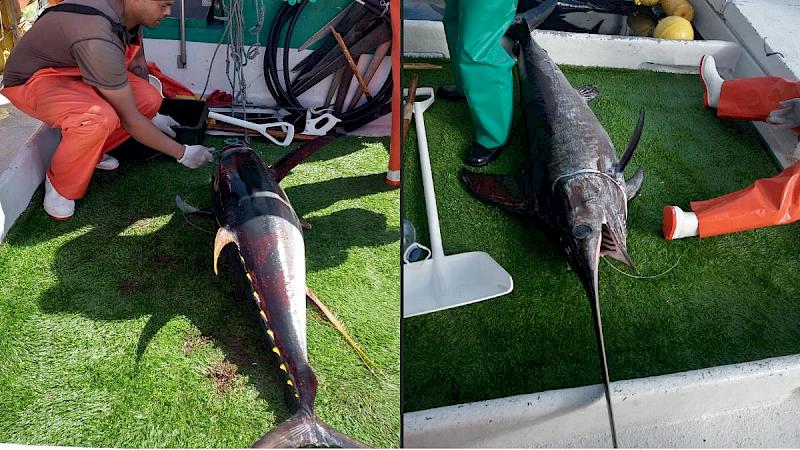
You were on board a tuna and swordfish fishing vessel, so where do sharks come into it?
The Pelagic longline fishery in South Africa hangs hooks on a longline near the water’s surface to catch various Tuna species (Yellowfin, Bluefin, Bigeye, and Albacore) and Swordfish (Xiphias gladius). Although sharks are not actively targeted, it is inevitable that these natural predators will be attracted to the bait thrown into the water and bite onto the hooks.
A large number of pelagic sharks, particularly the Blue Shark Prionace glauca and Shortfin Mako Isurus oxyrinchus, latch onto the hooks and are brought onboard, stored, and taken back to shore as a secondary catch to the main target species. Sharks form an important part of the overall financial gain for a fishing trip.
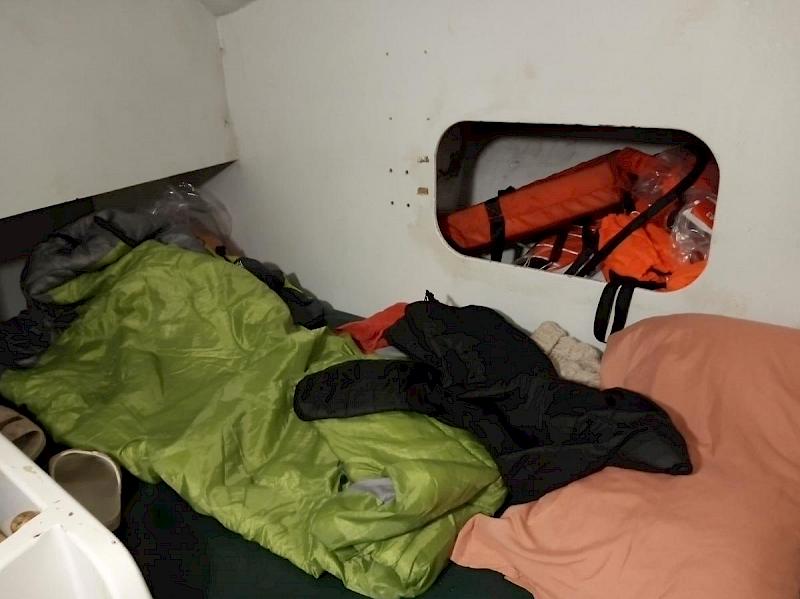
How was it living onboard?
We did quite a bit of prep work before the fishing trip and put measures in place to mitigate any risks and ensure my safety onboard. This includes undertaking a risk assessment, completing a SAMSA-approved training course for safety at sea and personal survival techniques, meeting the captain and crew prior to the trip, and making sure I have all the correct gear for living onboard a fishing vessel.
The crew were really accommodating, making an extra effort to make me feel safe and comfortable.
Then, after a night of bad weather, big swells, rolling around all night, and waking up with knots in my tummy, seasickness hit, on the morning of the third day, and again on the fifth. I couldn't eat. I couldn't talk. I couldn't even smile. My body and mind were screaming at me to get off the boat immediately.
One of the fishermen, with a sweet addiction, walked past where I was sitting and dropped a lollipop in front of me to ease my nausea. They were all really kind and encouraged me that everything would be fine.
The owner of the vessel called on the radio one evening to talk with me. He told me, “You need balance to survive this ship.”
He suggested that I sleep on the couch on the bridge of the boat, which helped a lot. It was the most stable part of the ship, and I didn’t feel the motion as much as in the cabin.
Once it was over, I felt like a new person again. Often, I found myself thinking, “it’s peaceful out here. Life is simpler.”
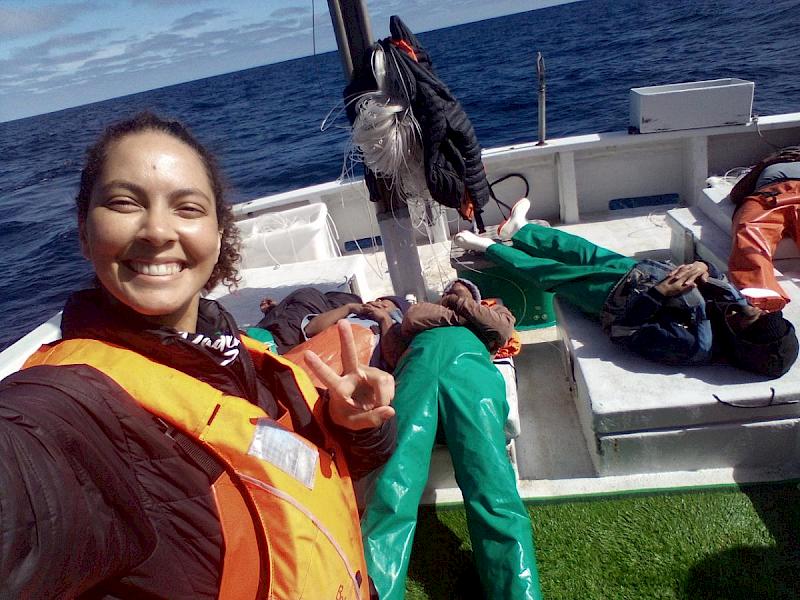
Was there anything that particularly struck you across the eight days?
For the first time, I saw a Blue Shark alive and swimming in the ocean. Previous to that I'd only ever seen them dead, as frozen trunks or dried fins. It had the most beautiful blue shimmer, with those characteristic long pectoral fins directing its path through the water. He was majestic.
That reinforced my passion to make sure these sharks are safeguarded (facilitated in part through the development and adoption of SharkTrace) and only harvested at levels that are sustainable. Balance really was the word of the moment. Not only the physical balance crucial to surviving life on that boat, but also the precious balance needed to achieve sustainability for nature and people – to ensure future survival of sharks, as well as the continuance of vital income to fishing communities.
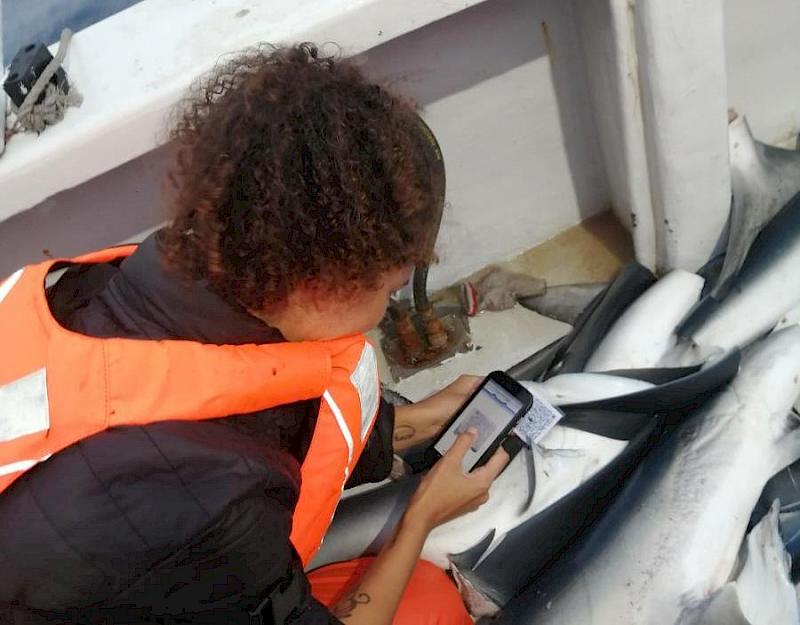
So, was the SharkTrace testing successful?
The trials were positive, and very beneficial for the app’s development.
There were a few glitches and things that can be made simpler to ensure the process is quicker on the boat, which the software developers are now responding to. But overall, the application does what it needs to do – it tracks and traces sharks caught at sea and captures information such as location of the catch, species, and how it is processed (e.g. fins removed and attached to trunks).
What did the fishers make of the app?
The fishers were curious about SharkTrace, but did not fully understand what the fuss was about. For them, Tuna is the big fish and where the money is, so why are we bothering with sharks?
It underscored a need for awareness-raising; they did not know about the current sustainability and overfishing issues associated with sharks. They did not realise the scale of the shark trade.
In addition, although sharks form an important part of the overall success of the fishing trip, they can also be seen as pests by the fishermen.
It is a lot more dangerous to bring sharks onboard compared to Tuna and Swordfish, and releasing the juvenile sharks (whose teeth are very sharp!) back into the ocean can be a hassle.
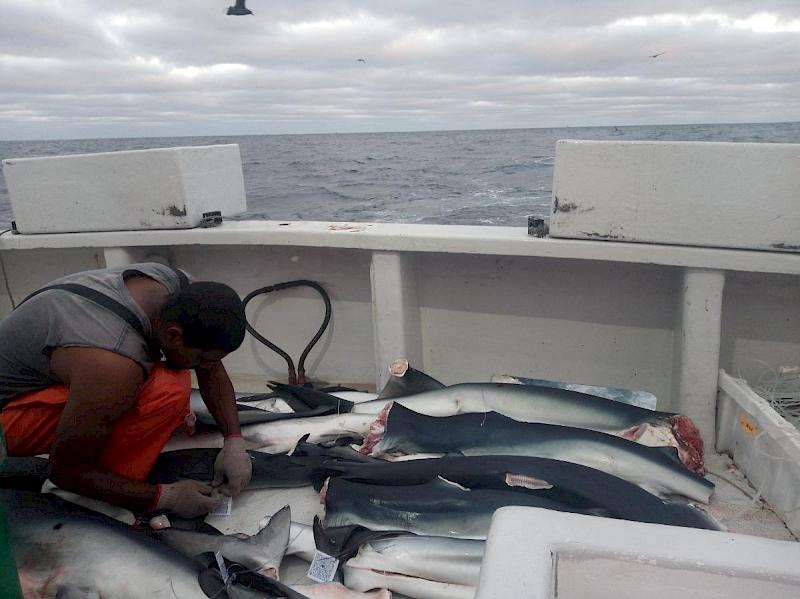
What’s next for SharkTrace?
The application requires further testing, including on larger Foreign Flagged Vessels fishing within South African waters, as they catch bigger volumes and are at sea for months at a time which requires more rigorous monitoring.
The hope would be to implement this traceability system in fisheries that catch sharks worldwide. While voluntary uptake of important sustainability tools like SharkTrace is ideal, uptake of traceability in shark fisheries is very limited and we can’t keep waiting as more sharks become threatened. Mandatory adoption is going to be essential in the mix of management options going forward.
And what’s next for you?
After the changes and upgrades to the software, we will be testing the full traceability system with this vessel and potentially with other fishing vessels in the fleet that are catching sharks as secondary catch. These trials will involve tracing the sharks from when they are caught at sea until they are landed in the Harbour, then following them all the way through the processing factory until finally, the products are exported out of the country.
What will you take away from this experience?
It’s an experience that I will never forget. I got to understand the life of the fishermen and the daily risks they face each time they sail out into the open ocean. I have a new sense of understanding and empathy for the work they do.
It was also a good experience for my journey in conservation – seeing first-hand what happens at sea and gaining a fresh perspective on what we must do to protect sharks and people.
About Shark Conservation Fund
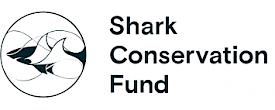
This project has been funded by the Shark Conservation Fund
www.sharkconservationfund.org


